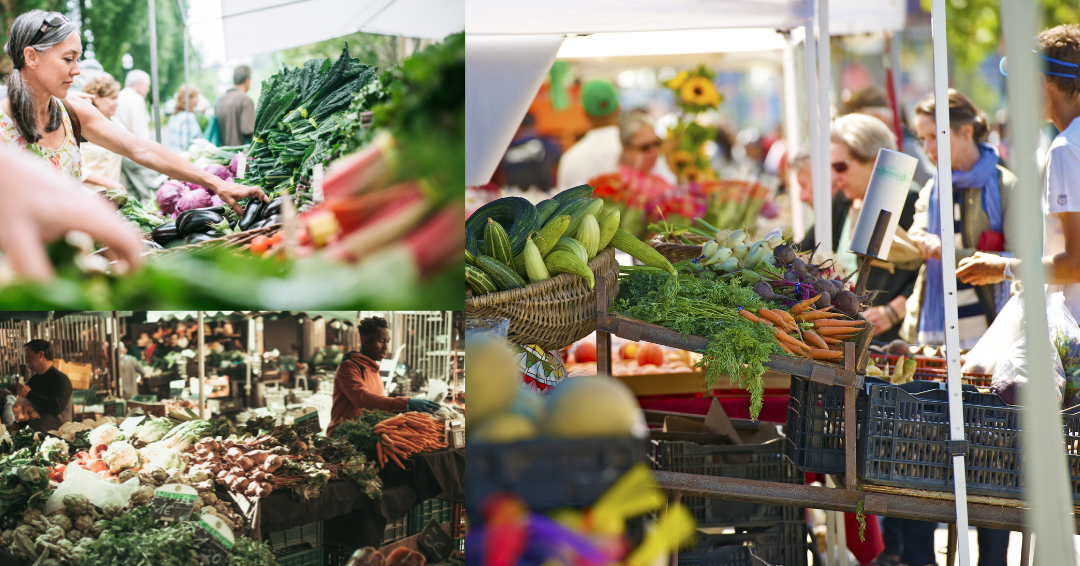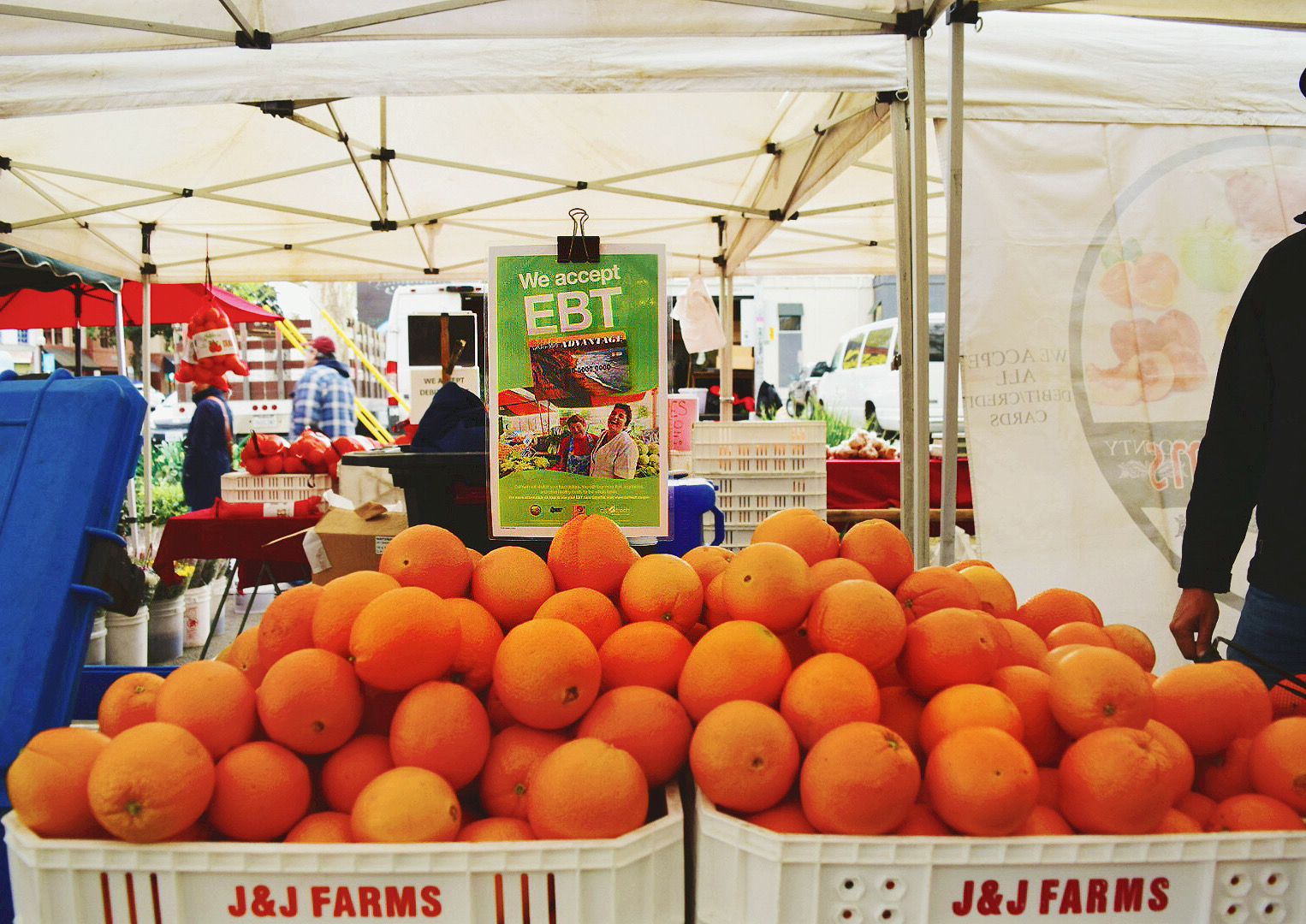A Beginner’s Guide to Farmers’ Markets
Farmers’ markets are beloved by their repeat customers, but for first-time visitors who aren’t familiar, they can seem a bit daunting at first. We are here to help clear away that fear with this beginner’s guide to farmers’ markets!
You will find these places to be welcoming, fun, and easy to manage. There’s a reason the farmers’ market is almost as old as agriculture itself.

Find a farmers’ market near you and make sure it is in season.
You can use the following resources:
- Alchemist CDC’s Sacramento & Yolo Farmers’ Market Map
- Alchemist CDC’s Sacramento & Yolo Farmers’ Market Directory
- The Ecology Center’s Farmers’ Market Finder
Plan ahead.
If you find all of the options at a farmers’ market overwhelming, it might help to plan your meals ahead of time with produce that is currently available. You can check out the Seasonal Food Guide to get an idea of what fruits and vegetables are likely to be available.
Pack what you need for your shopping trip:
- A form of payment or two:
- Some vendors accept credit cards but none prefer it. You will do best by avoiding credit cards.
- Some markets have ATM machines to withdraw cash from your debit card, but these usually charge processing fees.
- Cash is readily accepted and small bills are preferred.
- If you receive CalFresh benefits, bring your EBT card (check the market guides linked above). Most markets (but not all) accept EBT and many have Market Match dollars to help stretch your CalFresh benefits. Jump to the CalFresh/EBT section for more information on how this work.
- Some markets also accept WIC/Farmers’ Market Nutrition Program checks.
- Some vendors accept credit cards but none prefer it. You will do best by avoiding credit cards.
- A bag to carry home your purchases. People use all sorts of bags: tote bags, backpacks, plastic bags from the grocery store, reusable shopping bags, or even foldable shopping carts. The type of bag doesn’t matter, but you will be glad you have a way to get your groceries safely home.
- A water bottle or reusable cup. You might want to hydrate, especially on a hot day.
- A cooler or insulated bag if you are planning on purchasing meats, cheeses, or other perishable items that require cold storage.
- Your home compost if you visit one of these farmers’ markets that accept scraps for community composting.
- Do NOT bring your dog unless it is a service animal. California law prohibits certified farmers’ markets from allowing animals (except service animals) from the areas of a market where food is sold. If you are coming with a friend who can keep your dog on leash outside of the vending area until you are done shopping, you can enjoy the outing with your dog and abide by the public health policy.
Getting to the market:
- If it is possible for you, many people find farmers’ markets to be especially enjoyable if accessed by foot, bicycle, wheelchair, or scooter.
- If you ride your bike, utilize the free bike valet at the Midtown Farmers’ Market.
- Many markets are located near public transportation and are accessible by bus or light rail. You can get help planning your route in Sacramento County at this page or in Yolo County at this link.
- If you need to reach the market by car, car-pooling can be a plus! Farmers’ markets don’t just offer great food but an opportunity to socialize while you shop.
- Tip: be aware of when the market ends and leave yourself plenty of time to shop. Farmers must stop selling and start packing up at the listed end time.
At the market:
- It’s a great idea to walk through the market once before you decide which vendors to return to to make your purchases. Someday, you will know who your favorite vendors are, but even then it’s worth giving new sellers a try.
- Don’t be afraid to ask farmers for recommendations, for help getting the ripest fruit, or about the price if it isn’t listed. Getting to talk with the growers is part of what makes a farmers’ market special. Just be sure not to hold a long conversation if other customers are piling up behind you. You don’t want to cost a farmer business if other customers leave after waiting too long.
- If a farmer is offering samples, try a sample! You might discover a new favorite food. Do NOT help yourself to produce that isn’t specifically offered as a sample.
- Don’t haggle. There may be some markets where haggling is a part of the culture, but in general farmers have priced their product at a dollar amount they need in order to remain in business.
- Keep in mind the effect of timing. Getting to the market early often means cooler temperatures, better selection, and the most beautiful produce. Getting to the market at the end of the day means warmer temperatures, likely means the best-looking produce will be gone (but remember, imperfect produce can still taste just as good), but may also mean some vendors are selling more of their produce for special end-of-the-day deals.
- If the market you visit is mostly out of your price range, consider trying a different market in the future. Different farmers’ markets have different clientele and customer bases and the farmers sometimes charge different prices at different markets. That’s not greedy; the more well-off markets make it possible for farmers to stay in business and offer lower prices in less well-off areas.
- If you are planning to use CalFresh/EBT or Farmers’ Market Nutrition Program (FMNP) checks, be sure to read the relevant sections below.
- Enjoy the market! You belong there.
Shopping with your CalFresh/EBT or Pandemic EBT (P-EBT) card
- Locate the EBT booth or Market Info booth
- Tell the booth staff or volunteers how much you would like debited from your EBT card to spend with the farmers
- The staff or volunteers will slide your card through the EBT machine, you will enter your PIN and when the sale is complete, you will get a receipt along with your purchased EBT market vouchers
- The market vouchers are $1 a piece and must be spent as a whole dollar (no change can be given)
- They never expire
- They work on all EBT eligible items
- If the market offers a Market Match Incentive, you can earn up to $10 free dollars for fresh produce when using your EBT card
- These are $1 a piece and must be spent as a whole dollar (no change can be given)
- They never expire
- Only to be used on fresh fruits, vegetables, herbs or a food-producing plant
- Spend your CalFresh/EBT and Market Match with participating vendors!
- Vendors will have a sign at their booth showing they accept EBT (often it is lime green and easy to spot)
- If you aren’t sure, ask!
- The vouchers spend just like cash accept that no change can be given for less than a dollar.
- Are you interested in enrolling in CalFresh? You can stop by the CalFresh booth at any of the farmers’ markets staffed by Alchemist CDC for more information on eligibility or you can explore eligibility and apply for CalFresh at this link.

Shopping with your WIC/Farmers’ Market Nutrition Program (FMNP) checks
- These purple or blue printed checks can be spent directly with the farmers, no need to stop at the Information booth first
- Look for vendors with a “WIC accepted here” sign, usually hanging off the banner at the back of their tent
- Please note, to use WIC/FMNP at a market, the market must be approved and individual vendors must be approved. At present, several markets are approved but not many vendors at these markets are approved and participating.
- This check can be used for all fresh produce items
- One whole check must be used with one vendor – change cannot be given
- Interested in applying for FMNP checks? Learn more and apply at this link.
